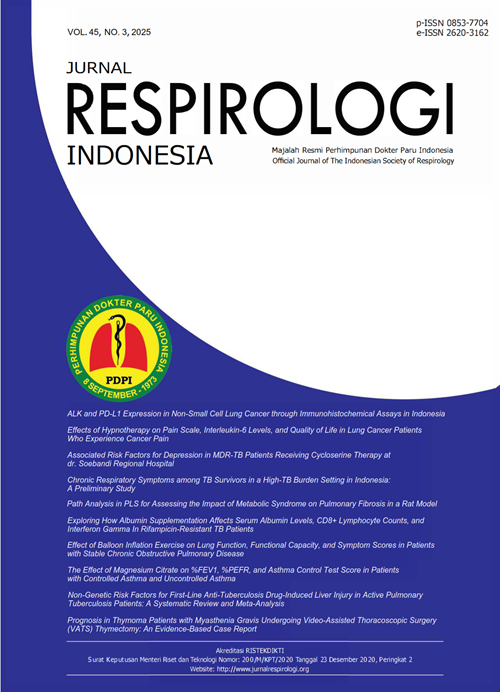Path Analysis in PLS for Assessing the Impact of Metabolic Syndrome on Pulmonary Fibrosis in a Rat Model
DOI:
https://doi.org/10.36497/jri.v45i3.889Keywords:
lung fibrosis., male Sprague Dawley rats, metabolic syndrome, PPARγAbstract
Background: Metabolic syndrome (MetS) is characterized by obesity, dyslipidemia, hyperglycemia, and insulin resistance, which are associated with increased risk for pulmonary fibrosis. This study investigates the impact of MetS on pulmonary fibrosis in a rat model using Partial Least Squares (PLS) path analysis.
Methods: Sprague Dawley rats were fed a high-fat, high-fructose diet for 37 weeks to induce MetS. Key metabolic parameters, including body weight, lipid profiles, fasting blood glucose, fibrosis markers and Aschroft scores, were assessed. PLS path analysis was conducted to explore the relationships between these variables and their influence on pulmonary fibrosis.
Results: PLS path analysis identified a strong correlation between increased body weight and MetS development (path coefficient=0.977). Dyslipidemia, characterized by elevated triglycerides and reduced HDL cholesterol, was also associated with MetS. A novel association was found between glucose dysregulation and pulmonary fibrosis (R2=0.908; path coefficient=0.947), suggesting that hyperglycemia contributes to lung fibrosis. Reduced PPARγ expression was associated with insulin resistance and inflammation, implicating it in fibrotic processes.
Conclusion: This study highlights the role of metabolic disturbances in promoting pulmonary fibrosis in MetS. PLS path analysis effectively identified key metabolic pathways, suggesting potential targets for therapeutic intervention to mitigate MetS effects and prevent fibrosis. Further research is warranted to explore these pathways and develop targeted therapies.
Downloads
References
1. Rochlani Y, Pothineni NV, Kovelamudi S, Mehta JL. Metabolic syndrome: Pathophysiology, management, and modulation by natural compounds. Ther Adv Cardiovasc Dis. 2017;11(8):215–25.
2. Chomsy IN, Rohman MS, Khotimah H, Bramantyo BB, Auzan A, Lukitasari M, et al. Effect of the ethanolic extract of green tea and green coffee on cardiac fibrosis attenuation by suppressing activin-a and collagen-1 gene expression. In: AIP Conference Proceedings. AIP Publishing; 2022.
3. Tsai MJ, Chang WA, Liao SH, Chang KF, Sheu CC, Kuo PL. The effects of epigallocatechin gallate (EGCG) on pulmonary fibroblasts of idiopathic pulmonary fibrosis (Ipf)—a next-generation sequencing and bioinformatic approach. Int J Mol Sci. 2019;20(8):1958.
4. Yang J, Xue Q, Miao L, Cai L. Pulmonary fibrosis: A possible diabetic complication. Diabetes Metab Res Rev. 2011;27(4):311–7.
5. Baffi CW, Wood L, Winnica D, Strollo PJ, Gladwin MT, Que LG, et al. Metabolic syndrome and the lung. Chest. 2016;149(6):1525–34.
6. Honda K, Marquillies P, Capron M, Dombrowicz D. Peroxisome proliferator-activated receptor γ is expressed in airways and inhibits features of airway remodeling in a mouse asthma model. Journal of Allergy and Clinical Immunology. 2004;113(5):882–8.
7. Saifur Rohman M, Lukitasari M, Nugroho DA, Ramadhiani R, Widodo N, Kusumastuty I, et al. Decaffeinated light-roasted green coffee and green tea extract combination improved metabolic parameters and modulated inflammatory genes in metabolic syndrome rats. F1000Res. 2021;10:467.
8. Siersbæk R, Nielsen R, Mandrup S. PPARγ in adipocyte differentiation and metabolism - Novel insights from genome-wide studies. FEBS Lett. 2010;584(15):3242–9.
9. Wang YC, Dong J, Nie J, Zhu JX, Wang H, Chen Q, et al. Amelioration of bleomycin-induced pulmonary fibrosis by chlorogenic acid through endoplasmic reticulum stress inhibition. Apoptosis. 2017;22(9):1147–56.
10. Lefterova MI, Steger DJ, Zhuo D, Qatanani M, Mullican SE, Tuteja G, et al. Cell-specific determinants of peroxisome proliferator-activated receptor γ function in adipocytes and macrophages. Mol Cell Biol. 2010;30(9):2078–89.
11. Lestari IP, Chozin IN, Sartono TR, Sasiarini L, Yudhanto HS. Effect of a high-calorie diet on pro-to anti-inflammatory macrophage ratio through fat accumulation in rat lung tissue. Medical Journal of Indonesia. 2023;32(4):212.
12. Tudela J, Martínez M, Valdivia R, Romo J, Portillo M, Rangel R. Effects of budesonide combined with salbutamol on pulmonary function and peripheral blood eosinophiles and IgE in patients with acute attack of bronchial asthma. Nature. 2010;388:539–47.
13. Ahmadian M, Suh JM, Hah N, Liddle C, Atkins AR, Downes M, et al. Pparγ signaling and metabolism: The good, the bad and the future. Nat Med. 2013;19(5):557–66.
Downloads
Published
Issue
Section
License
Copyright (c) 2025 Muli Yaman, Susanthy Djajalaksana, Ngakan Putu Parsama Putra, Hendy Setyo Yudhanto

This work is licensed under a Creative Commons Attribution-ShareAlike 4.0 International License.
- The authors own the copyright of published articles. Nevertheless, Jurnal Respirologi Indonesia has the first-to-publish license for the publication material.
- Jurnal Respirologi Indonesia has the right to archive, change the format and republish published articles by presenting the authors’ names.
- Articles are published electronically for open access and online for educational, research, and archiving purposes. Jurnal Respirologi Indonesia is not responsible for any copyright issues that might emerge from using any article except for the previous three purposes.
















